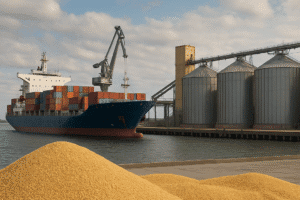The intricate relationship between exchange rates and the global grain market has long captured the attention of economists, traders, and policymakers. Fluctuations in currency values can send ripples through commodity prices, reshape trade flows, and alter the competitive landscape for exporters and importers alike. This article examines the mechanisms by which currency movements influence grain export dynamics, explores the implications for key stakeholders, and highlights effective approaches to managing the financial risks inherent in this vital sector.
Exchange Rate Dynamics and Grain Price Formation
Exchange rates play a pivotal role in determining both the cost of production for exporters and the purchasing power for importing nations. When the domestic currency weakens relative to major trading partners, local producers may find their grain more competitive on the international stage. Conversely, a stronger domestic currency can erode export margins, making shipments less attractive to overseas buyers.
Mechanisms of Price Transmission
- Spot rates: Immediate currency conversions influence the headline price of grain delivered to port.
- Forward contracts: Futures markets often incorporate anticipated exchange rate adjustments into their quoted values.
- Trade invoicing: Contracts denominated in US dollars or euros shift currency risk onto exporters or importers, depending on the agreement.
International grain traders rely on a combination of market intelligence and financial models to forecast how shifts in major currency pairs, such as USD/EUR, USD/BRL, or USD/AUD, will affect the landed cost of wheat, corn, or barley. These forecasts in turn inform decisions around contract timing, volume commitments, and hedging strategies.
Impact on Export Competitiveness and Market Access
A volatile currency environment can either open doors or impose barriers for grain-exporting nations. By understanding the nuances of currency movements, stakeholders can better navigate the international marketplace and secure favorable trade terms.
Benefits of Local Currency Depreciation
- Enhanced export volumes: A depreciated currency effectively lowers the export price when measured in foreign currency terms, stimulating demand.
- Market share gains: Price-sensitive buyers may shift orders to suppliers offering lower-cost grain.
- Improved profitability: Exporters enjoy wider profit margins when production costs remain stable in local currency.
Challenges of Currency Appreciation
- Reduced competitiveness: A stronger home currency raises export prices, potentially diverting volumes to alternative origins.
- Pricing pressure: Exporters may need to absorb part of the currency gain to maintain market share, squeezing margins.
- Strategic realignment: Long-term currency strength can push producers to seek new markets or diversify product offerings.
For major grain exporters such as the United States, Brazil, and Australia, the correlation between their currency indexes and agricultural commodity prices is closely monitored. Government export programs, subsidies, and trade agreements often factor in these currency dynamics to optimize national agricultural strategies.
Risk Management Strategies for Grain Exporters
Managing currency risk is essential for both established and emerging players in the grain market. Exporters employ a suite of financial tools and operational tactics to shield their earnings from unpredictable exchange rate swings.
Hedging Instruments
- Currency forwards: Lock in exchange rates for future settlement dates to guarantee known conversion rates.
- Options: Purchase currency options to benefit from favorable moves while limiting downside exposure.
- Swaps: Exchange currency cash flows over a specified period, matching export revenues to production costs.
Operational Adjustments
- Invoicing flexibility: Negotiate contracts in both local and foreign currencies to balance risk.
- Geographical diversification: Spread shipments across multiple markets to mitigate region-specific currency shocks.
- Cost base alignment: Source inputs from countries whose currencies move in tandem with export proceeds.
While financial derivatives offer precise risk transfer mechanisms, they carry their own complexity and counterparty risk. Successful grain exporters often blend hedging with agile commercial policies, ensuring they are neither over-hedged nor too exposed to spot rate volatility.
Macroeconomic Factors and Policy Interventions
Government actions and broader economic conditions exert a significant influence on currency values, which in turn affect grain exports. Understanding the policy landscape is crucial for crafting sound export strategies.
Monetary and Fiscal Policy
Central banks’ decisions on interest rates can drive short-term currency appreciation or depreciation. For example, a rate hike may attract foreign capital inflows, strengthening the currency and raising the cost of grain exports. Conversely, expansionary policy can lead to a weaker currency, boosting export profitability but fueling domestic inflation.
Trade Regulations and Tariffs
Import tariffs, quotas, and non-tariff barriers can either cushion or amplify the impact of currency fluctuations. A sudden imposition of export duties in a key grain supplier country can offset the benefits of a depreciated currency, raising global prices and shifting trade patterns. Conversely, the removal of trade barriers enhances the transmission of currency advantages to end-buyers.
Strategic Reserves and Intervention
Some governments maintain grain reserves and intervene in currency markets to stabilize farmer incomes and maintain food security. These interventions can dampen the immediate effect of currency swings on export volumes, but may also distort global price signals and lead to inefficiencies.
Case Studies: Lessons from Leading Grain Exporters
Examining real-world examples helps illustrate how currency fluctuations shape grain export outcomes.
United States: Dollar Strength and Market Share
During periods of dollar appreciation, US corn and soy exports often face headwinds as competing suppliers like Brazil or Argentina offer more attractive prices in local currency terms. US exporters typically respond by securing long-term forward contracts and leveraging government export credit programs to sustain market share.
Brazil: Reais Depreciation as a Tailwind
When the Brazilian real weakens, the country’s soy and corn shipments surge. Exporters capitalize on the cost edge by expanding infrastructure investments in ports and inland storage, ensuring they can meet the heightened demand created by favorable exchange rates.
Australia: Diversification Amid Currency Volatility
The Australian dollar’s correlation with commodity prices means that wheat exporters must constantly adapt. By diversifying into value-added products such as durum wheat and by exploring emerging Asian markets, Australian exporters mitigate the risks of AUD fluctuations and enhance overall market access.
Conclusion
Currency fluctuations are a double-edged sword for grain exporters. While a weaker domestic currency can unlock export growth and boost profits, excessive volatility can undermine financial stability and erode margins. Through a combination of sound risk management practices, strategic policy support, and commercial agility, stakeholders in the grain sector can navigate the complexities of exchange rate dynamics and secure their position in the competitive global marketplace.













